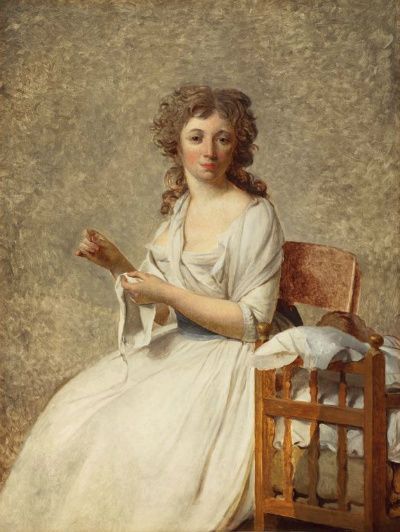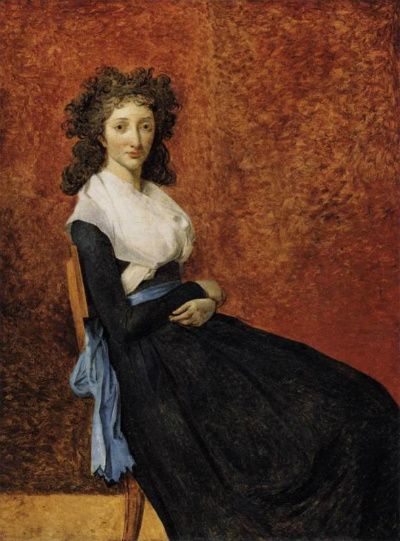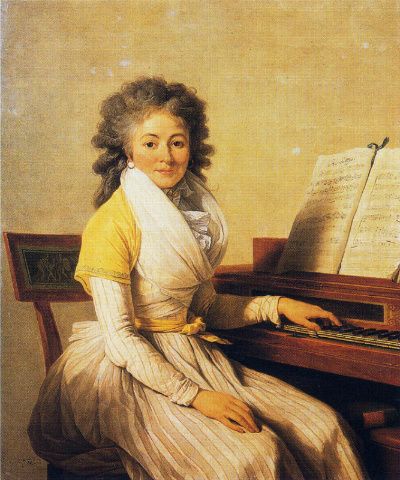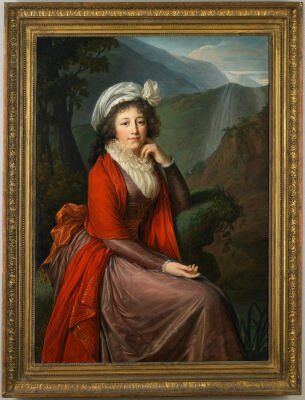Self Portrait With A Harp (Part 2)
2:58 PMPart 1
The Chemise a la Reine
Today's post considers other garments Ducreux might have worn in her portrait. For background on the chemise a la reine, please click the link at the top to read my post about it.

Self Portrait with a Harp, by Rose Adélaïde Ducreux, c. 1791. In the collection of The Metropolitan Museum of Art.
By the early 1790s, fashion periodicals were urging women to dress in a more simplistic manner. Combinations of jackets and skirts were popular democratic wear, the Journal de la Mode et du Gout declaring in 1790 that “This undress is called The Democrat.” Also popular were French versions of English styles such as riding habits and the redingote. On September 11, 1789, the Magasin des Modes Nouvelles wrote “We have all become soldiers”, emphasizing that women had a role to play in the Revolution as well. While men fought in the ‘battlefield’, women could do their part by wearing appropriate fashions. Women were urged to wear fabrics made in France, and of simpler fibers such as woolen stuffs and printed cottons. Overall, high luxury in dress was beginning to disappear. The Journal de la Mode et du Gout wrote in June 1790: “Luxury is dead, cried out the shopkeepers. Already gold and silver are no longer used in finery.” And indeed, a more democratizing choice for Ducreux would have been to paint herself in a jacket and skirt combination or a redingote, made of less costly fabrics.
Another fashion option for Ducreux was the chemise a la reine, introduced by Marie Antoinette in the early 1780s. However, to wear the chemise a la reine would have associated her with Marie Antoinette. Although, when looked at outside its political context, the chemise a la reine seems to indicate the egalitarian principles of the Revolution with its light, inexpensive fabrics and simple construction, it’s association with Marie Antoinette forever tainted the garment.
The robe a l’anglaise worn by Ducreux, while initially seeming to symbolize luxury, is in actuality in line with Revolutionary ideals. The robe a l’anglaise, literally meaning ‘English dress’, was also a new style of garment in the 1780s. Previously, women had worn the elaborate robe a la francaise, a garment which took an enormous amount of fabric to construct and decorate. The robe a l’anglaise had developed in England as an expression of the simple English aesthetic, and indeed was extremely simple in cut and décor when compared with the robe a la francaise. Furthermore, in France, to wear English styles was to align oneself with the constitutional monarchy of England, which the early years of the Revolution strove for. For Ducreux to wear a robe a l’anglaise, she not only embraced traditional gender roles but aligned herself with a more egalitarian society.

Madame de Pastoret and her Son by Jacques Louis David, c. 1791. In the collection of The Art Institute of Chicago.

Mme Charles-Louis Trudaine by Jacques Louis David, c. 1791. In the collection of The Louvre.
Ducreux’s fashion is on the more luxurious end of the spectrum when considered against other portraits from the period. Jacques Louis David painted Mme Charles-Louis Trudaine in 1791-92, and Madame de Pastoret and her Son in 1791-92. Both portraits feature a plain background and women in very simple garments, of one basic color (white in the case of Madame de Pastoret and a dark gray in the case of Mme Trudaine) and a non-lustrous fabric, most likely signifying a cotton or wool. However, fashion historian Aileen Ribeiro explains that “this paradox can partly be explained by a deliberate desire on the part of the artist to subdue intrusive details of fashion which might detract from the character of the sitter, or a tactful decision, in a time of great social and political stress, on the part of the sitter to be portrayed in a simple, informal costume.”

Mademoiselle Duplant by Francois-Andre Vincent, 1793. In the collection of the Musée Calouste Gulbenkian, Lisbonne.
Other painters portrayed a simpler fashion aesthetic as well. Francois-Andre Vincent’s painting of Mademoiselle Duplant from 1793 shows the sitter in a striped dress of non-lustrous material, most likely made of a non-silk fiber, wrapped in a plain white muslin fichu and lightly embroidered yellow shawl. In 1792, Henri-Pierre Danloux painted Mademoiselle Rosalie Duthe in a similar dishabille. The sitter wears a simple white dress, most likely made of a fine muslin, with a sleeveless white bodice over top, tied with lavender ribbons.

Maria Theresa of Bourbon by Elisabeth Vigee-Lebrun, 1790. In the collection of the Musée Condé, Chantilly.
Portraits by Elisabeth Vigée-Lebrun lean towards a more luxurious aesthetic. In her portrait of Maria Theresa of Bourbon from 1790, the sitter wears a robe of grey-brown velvet, with an underdress of lustrous blue silk, tied around the waist with an embroidered golden sash. Another Vigée-Lebrun portrait, of Countess Maria Theresia Bucquoi from 1793, shows the sitter in a puce silk taffeta gown, the coloring significant in that Marie Antoinette popularized the shade in 1775, with an orange sash and embroidered red shawl. While these paintings show fashion more in line with the aesthetic presented by Ducreux, it is worth noting that Vigee-Lebrun fled France in 1789, and was considered an emigrés. Thus her paintings are not an accurate representation of trends in portraiture during this period.

Countess Maria Theresia Bucquoi by Elisabeth Vigee-Lebrun, 1793. In the collection of the Minneapolis Institute of Arts.
How, then, does Ducreux’s painting fit in with its contemporaries? It is more reminiscent of previous styles of portraiture than contemporary styles, which in general show a movement towards simplicity. One view is that Ducreux’s luxurious satin fabrics are a celebration of the French textile industry, which had suffered from the popularity of imported muslins. However, less expensive fabrics of French origin were encouraged in the fashion press, and perhaps a more politically savvy move for Ducreux would have been to paint herself in a less luxurious garment. But despite its luxury, Self Portrait with a Harp was admired by critics, its more Revolution-friendly aspects perhaps outweighing the display of luxury in the textiles.



3 comments